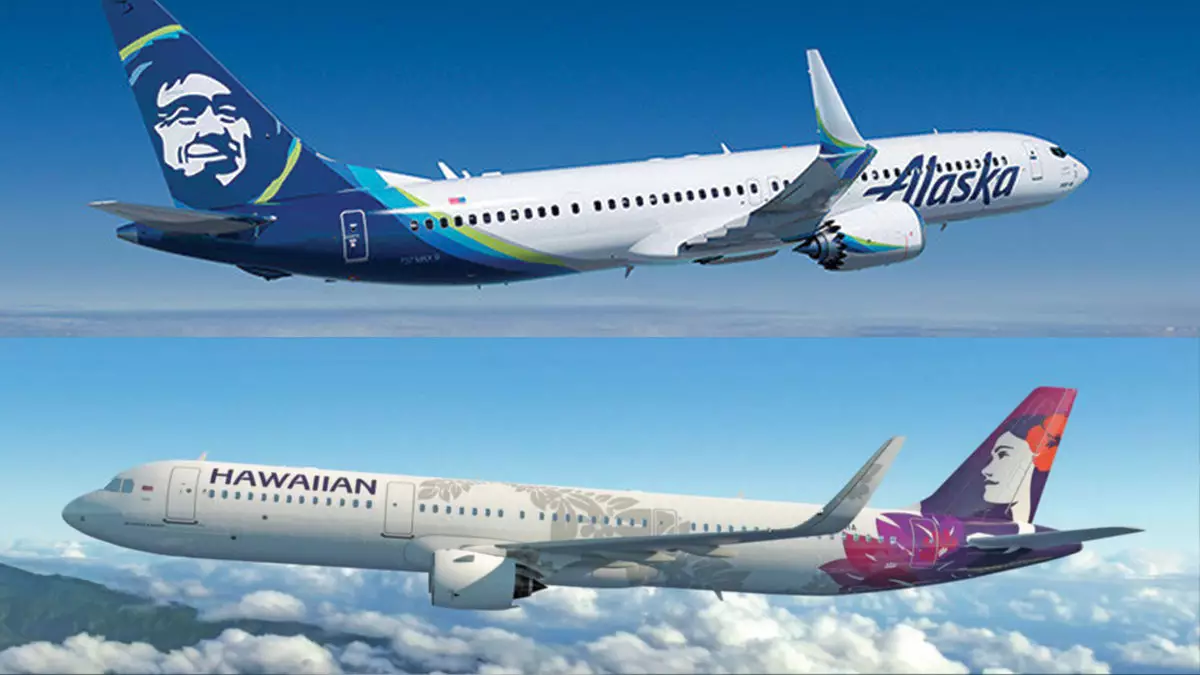In a significant move within the aviation industry, Alaska Airlines is poised to complete its $1.9 billion acquisition of Hawaiian Airlines, following the conditional green light from the U.S. Department of Transportation (DOT). This merger has garnered substantial attention as it marks a pivotal moment for both airlines, reflecting broader trends of consolidation in the airline sector. The approval process had already witnessed a crucial milestone when the Justice Department opted not to contest the deal last month. With the latest endorsement from the DOT, both airlines can now channel their efforts towards integrating operations under a singular operating certificate, a crucial step that will define their future trajectory in the market.
Unlike the Justice Department’s straightforward approval, the DOT has attached specific conditions aimed at safeguarding competition and ensuring customer satisfaction. These provisions, expected to last six years from the acquisition’s closure, mandate that the newly merged entity will not only maintain but possibly expand services on routes where either carrier holds a monopoly or is one of the leading operators. Such regulations are pivotal; they aim to prevent market degradation and provide assurances to travelers that service integrity will prevail despite the merger.
Hawaii’s inter-island routes are particularly significant given their unique logistical context and the economic reliance on tourism in the region. Maintaining service levels on these critical routes is not just a regulatory expectation; it’s a lifeline for communities and businesses that depend on reliable air travel. Furthermore, by insisting on the preservation of interline agreements with regional partners such as Mokulele Airlines, the DOT is reinforcing the importance of regional connectivity in the Hawaiian archipelago.
In an age where customer service often plays a decisive role in consumer loyalty, the DOT’s stipulations for enhancing passenger experience are both prudent and necessary. Among these requirements is the need for Hawaiian Airlines to adopt Alaska Airlines’ family-friendly policies, including free adjacent seating for children traveling with adults. This move reflects a growing industry trend aimed at catering to families and ensuring their comfort during air travel.
Additionally, the compensation framework surrounding flight delays is a critical aspect of these regulations. Providing travel credits or frequent flyer miles for significant delays is a clear acknowledgment of customer frustrations and is likely to resonate positively with travelers, reinforcing the airlines’ commitment to customer satisfaction.
The requirements extend to serving military personnel, where both airlines are expected to offer more generous baggage allowances and fee waivers—an acknowledgement of their service and a strategic move to cultivate loyalty among service members and their families.
The integration of loyalty programs presents both a challenge and an opportunity for the newly unified entity. Alaska Airlines aims to preserve the value of HawaiianMiles, ensuring that customers experience a seamless transition as their miles convert to Alaska’s Mileage Plan. By guaranteeing that points earned prior to the merger remain valid, Alaska Airlines alleviates fears of devaluation, thus fostering trust among its customer base.
This strategic approach could bolster customer retention by allowing existing HawaiianMiles members to combine their rewards with Alaska’s Mileage Plan while ensuring that status benefits are honored during this transition. Such initiatives can help retain customer loyalty during a period of significant change, addressing potential concerns about the impact of the merger on individual members’ benefits.
With Alaska Airlines CEO Ben Minicucci maintaining his leadership role post-merger, continuity is assured amid the changes. Joe Sprague, currently the regional president for Hawaii and the Pacific at Alaska, is set to take over as CEO of Hawaiian Airlines. This organizational structure appears designed to ensure a smooth transition and maintain focus on regional operations while paving the way for unified operation under a single certificate.
As the combined entity navigates the complexities of integration, the retained brand identities of both airlines will continue to resonate with customers, preventing alienation while creating a more competitive force within the aviation market. Ultimately, the merger not only signals a transformative period for the operations of Alaska and Hawaiian Airlines, but it also emphasizes a commitment to enhancing consumer choice amid a consolidating market.
In embracing these conditions and operational strategies, the merged airlines will likely emerge more robust, catering effectively to the evolving needs of their passengers while solidifying their position in the competitive airline landscape.

